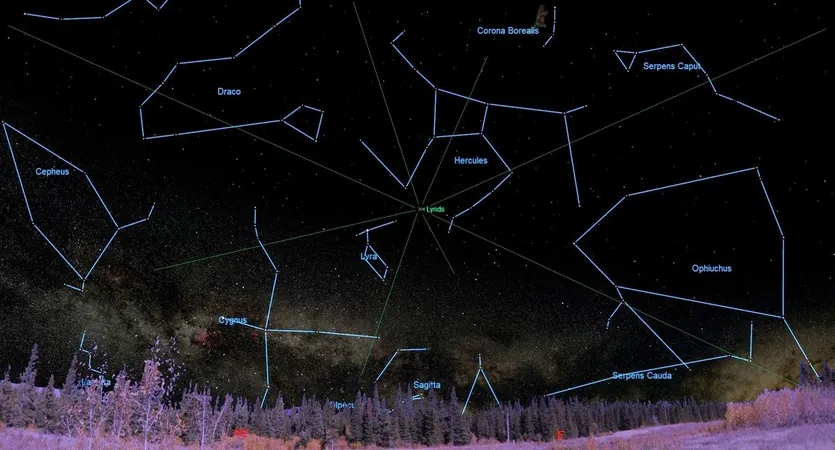
Get Ready for the 2025 Lyrid Meteor Shower: A Chance for a Spectacular Show!
2025-04-06
Author: Emily
After a long wait of nearly four months, stargazers across the globe can finally get excited as the Lyrid meteor shower returns this month! The Lyrids are renowned as one of the oldest meteor displays known to humanity and are a must-see for fans of shooting stars.
While many meteor showers grace our skies throughout the year, only a select few are categorized as "principal" displays, making them exceptional events for skywatchers. The previous notable show was the Quadrantids on January 3, but now the Lyrids will take the spotlight, marking a season of meteor-watching excitement.
Meteor expert Peter Jenniskens describes the Lyrids as the "proverbial swallow of spring" for northern hemisphere observers, who eagerly anticipate their arrival following the quiet months of winter when meteor activity is sparse.
A Great Year to Witness the Lyrids!
Mark your calendars: the peak of the Lyrid meteor shower is expected to occur on the morning of April 22. This year's conditions are particularly favorable, with a waning crescent moon only 36 percent illuminated, minimizing light interference. The moon will not rise until approximately 3:30 a.m. local time, allowing for optimal viewing under dark skies.
Timing is Key
The timing of the Lyrid peak can be tricky to pinpoint. Historically, maximum activity has been recorded around 1330 UTC (9:30 a.m. ET), based on data from observations spanning several years. However, recent variability suggests that the peak could happen anytime from as early as 10:30 UTC to as late as 18:00 UTC, particularly favoring western time zones like Mountain and Pacific where morning twilight might still be absent during these hours.
The best time to catch the meteors will be in the predawn hours. As midnight approaches, the bright star Vega, located in the constellation Lyra, will be rising majestically in the east-northeast sky. Prepare for a celestial spectacle as Vega climbs higher, becoming nearly overhead as dawn approaches.
Eyewitness Accounts of Historical Lyrid Displays
The Lyrids are known not only for their consistent appearances but also for surprising bursts of activity. Historically documented events have included stunning showers in 687 B.C. in China, and in 1803 in Richmond, Virginia, where townspeople witnessed meteors that "seemed to fall from every point in the heavens." These unexpected displays highlight the Lyrids' potential for astonishing moments.
Even more recently, spectacular bursts of around 90 meteors per hour were observed in 1982. While the average peak may only yield sightings of approximately one meteor every three to five minutes, the possibility of astonishing displays during this short window is what keeps observers coming back year after year.
An Unexpected Bonus?
But wait, there's more! Alongside the Lyrids, there’s a small chance of witnessing a brilliant fireball meteor that could lead to a meteorite drop. This hypothesis stems from observations of similar events in the 1960s. Astronomers speculate that Earth may encounter a sparse stream of meteoroids during the last week of April, possibly leading to exceptional fireballs and even meteorite falls.
For those adventurous enough to observe the night skies around April 23-25, keep an eye out for dazzling meteors charting a south-to-north path from the direction of the constellation Corvus, which could offer an unforgettable sight!
So, set your alarms for the early hours of April 22 and consider peeking out a day or two before and after for the best chance to catch the stunning Lyrid meteor shower—and maybe even a fireball! There’s nothing quite like the thrill of watching the cosmos put on a show just for you. Are you ready to be amazed? Get your cameras ready, and don’t miss out!









 Brasil (PT)
Brasil (PT)
 Canada (EN)
Canada (EN)
 Chile (ES)
Chile (ES)
 Česko (CS)
Česko (CS)
 대한민국 (KO)
대한민국 (KO)
 España (ES)
España (ES)
 France (FR)
France (FR)
 Hong Kong (EN)
Hong Kong (EN)
 Italia (IT)
Italia (IT)
 日本 (JA)
日本 (JA)
 Magyarország (HU)
Magyarország (HU)
 Norge (NO)
Norge (NO)
 Polska (PL)
Polska (PL)
 Schweiz (DE)
Schweiz (DE)
 Singapore (EN)
Singapore (EN)
 Sverige (SV)
Sverige (SV)
 Suomi (FI)
Suomi (FI)
 Türkiye (TR)
Türkiye (TR)
 الإمارات العربية المتحدة (AR)
الإمارات العربية المتحدة (AR)